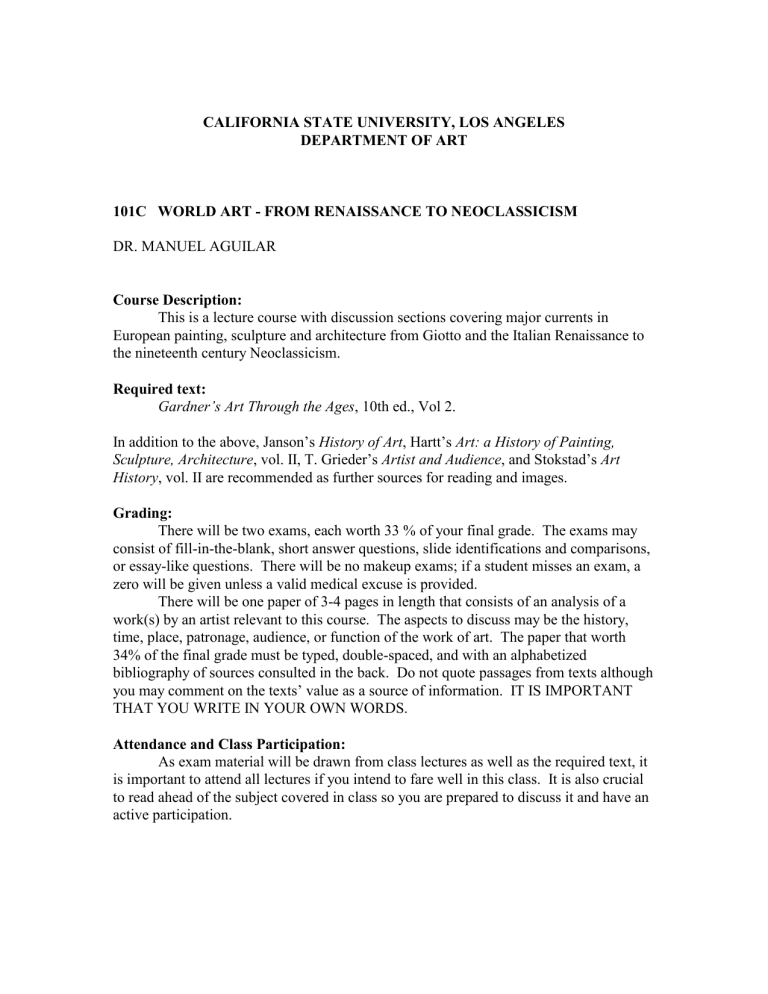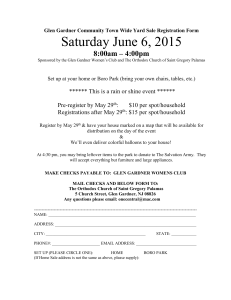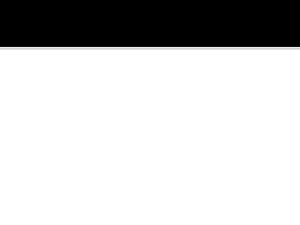ART 101C - California State University, Los Angeles

CALIFORNIA STATE UNIVERSITY, LOS ANGELES
DEPARTMENT OF ART
101C WORLD ART - FROM RENAISSANCE TO NEOCLASSICISM
DR. MANUEL AGUILAR
Course Description:
This is a lecture course with discussion sections covering major currents in
European painting, sculpture and architecture from Giotto and the Italian Renaissance to the nineteenth century Neoclassicism.
Required text:
Gardner’s Art Through the Ages
, 10th ed., Vol 2.
In addition to the above, Janson’s
History of Art
, Hartt’s
Art: a History of Painting,
Sculpture, Architecture , vol. II, T. Grieder’s Artist and Audience , and Stokstad’s Art
History , vol. II are recommended as further sources for reading and images.
Grading:
There will be two exams, each worth 33 % of your final grade. The exams may consist of fill-in-the-blank, short answer questions, slide identifications and comparisons, or essay-like questions. There will be no makeup exams; if a student misses an exam, a zero will be given unless a valid medical excuse is provided.
There will be one paper of 3-4 pages in length that consists of an analysis of a work(s) by an artist relevant to this course. The aspects to discuss may be the history, time, place, patronage, audience, or function of the work of art. The paper that worth
34% of the final grade must be typed, double-spaced, and with an alphabetized bibliography of sources consulted in the back. Do not quote passages from texts although you may comment on the texts’ value as a source of information. IT IS IMPORTANT
THAT YOU WRITE IN YOUR OWN WORDS.
Attendance and Class Participation:
As exam material will be drawn from class lectures as well as the required text, it is important to attend all lectures if you intend to fare well in this class. It is also crucial to read ahead of the subject covered in class so you are prepared to discuss it and have an active participation.
Course Schedule:
1) The Esthetic Categories and Terms of Art History. Gardner 3-19.
2) Byzantine and Gothic sources in Italy. Narrative in the work of Duccio, Simone
Martini, Cimabue and Giotto. Gardner 619-647.
3) Gothic elements in 15th-Century Northern (Flemish) art: Robert Campin, Van der
Weyden, Van Eyck brothers, and Bosch. Gardner 650-665.
4) The Revival of Classical Antiquity in 15th-Century Italian Art. Linear and
Atmospheric Perspective. Gardner 680-690.
5) Greek and Roman Classicism as model in 15th-Century Italian Architecture.
Gardner 690-705.
6) Revival of Greek Mythology in later 15th-Century Italian Art. Gardner 705-727.
7) The High Renaissance in Italy and Early 16th-Century Concepts of “Genius” and
“Masterpiece.” Gardner 730-745, 749-753.
8) Michelangelo as Sculptor, Painter and Architect. Gardner 745-760.
9) 16th-Century Venetian Architecture and Painting, and Landscape as a New Genre.
Gardner 771-787.
10) The Reformation in 16th-Century Italy and Spain. Mannerism and Deviation from the Classical Canon. Gardner 760-770, 810-815.
11) EXAM ONE and 16th-Century Northern European Painting. Germany and
Flanders. Dürer, a German Humanist; Prints as a Means of Popular Diffusion. Gardner
790-806.
12) The Counterreformation in 17th-Century Italy (Baroque) and the Power of the Image.
Bernini and Caravaggio. Gardner 818-828, 832-840.
13) Baroque Architecture , the Jesuit Order and Illusionistic Ceiling Painting.
Gardner 828-832, 840-842.
14) Baroque Painting and Patronage in Spain, Flanders and the Netherlands: Velazquez,
Rubens, Rembrandt, Hals and Vermeer. Gardner 842-865.
15) Baroque Classicism in England and France: Poussin and the Court of Louis XIV.
Gardner 865-877.
16) Rococó in 18th-Century France, Bavaria and England. Aristocratic Decadence vs.
Bourgeois Morality. Gardner 880-904.
17) 18th and 19th-Century Art. Rococó to Neoclassicism. The French Revolution and
Overthrow of the Monarchy. Gardner 904-921, 928-934.
18) Romanticism and the Exotic in Spain and France: 19th-Century Politics and
Psychology in art. Gardner 934-948, 954-957.
19) Social and Political Themes of the Contemporary World: Realism in Mid-19th-
Century as a Reaction against Romanticism. Millet, Courbet and Daumier.
Gardner 957-980.
20) EXAM TWO and Impressionism, Light, Movement and the Impact of Photography.
The disintegration of the Center. Gardner 980-994.
FINAL EXAM DAY: PAPER DUE.






